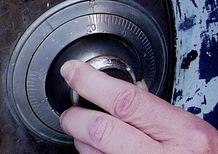The following is a guest-posting**:
Your very own efforts in securing your valuables are the exact tools upon which a clever burglar often depends. That may sound a bit ridiculous. In truth, it is fact. Statistics from law enforcement agencies point out time and time again that under-thinking the needs for the security of your personal goods is a common tendency among most home owners. That is not surprising. After all, the advertisement for a particular security provider stated that you would be safe, that they would take good care of your security needs. So, why should you worry? In addition, the answer to that is because the only way to have the upper hand in your security is not to be the consumer or client, but also to take on the responsibility of an actual partner to your own safety. You must know the common blunders and shoulder the responsibility of preventing them.
Making a good decision for the purchase of your safe is just the first step. You have seen it in movies. Even in the face of the most sophisticated systems, the burglar has a plan. In the movies it is often technology that wins out, but the sad truth is that in the real world it is most often simple blunders, missteps or oversights, carried out by the owner, that are the weaknesses in even the best designed safes. Simple, common blunders can make you an unwitting accomplice to your own safecracking.
All it often takes to undo the finest modern lock is just the casual conveyance or mislaying of a pass code. Computer-savvy kids learn to avoid obvious password dangers at an early age. It may seem that the number of permutations for combining 10-14-82 (in the case of a date of birth, for instance) and the letters in the name of one’s firstborn child are limitless. A little bit of experimental deciphering on your own should quickly reveal that such is just not the case. It only takes a few seconds for an astute operative with a good decryption program to punch through a random sweep of combinations and soon the game is over. If the burglar knows something about you and your family, the code puzzle can be made even more simple. Unfortunately, it is too often exactly that sort of scenario that plays out. Many professional thieves these days rely more upon their ability to assimilate background data on their target than upon their skills as a locksmith. They even manage to leave very little evidence behind.
It may sound absurd, but your own smudges and fingerprints, residual from repeated use, on the face around your tumbler housing can lead a sneak thief to your combination. Even leaving the tumbler of your safe in its final position can give your security away. These are not always apparent to the casual glance, but a smart safecracker is anything but casual. Take a moment to observe your own tendencies. Make notes about the key steps you feel you need to correct in your security routine and refer to them regularly as you refine your outlook. Remember that routines are habits. When it comes to security, habits are generally bad. Unless it will cause major disruptions, it is always good advice to change your habits and your passwords frequently.
Your bottom-line needs will determine your best choice for a modern safe. Most home owners may not need high-end vaults or redundant, multilevel monitoring, but it is important to understand the weaknesses of any safe you are considering. Basic understanding goes a long way. For instance, a remotely operated lock may be vulnerable to operation by an outside signal sources. Or a camera monitor above your safe could provide a birds-eye view for someone to compromise your combination. The list goes on and on. In the end, safecracking is the art of locating weaknesses.
**Lately, lack of time has prevented me from updating the site as often as I’d like, so I hired a couple students to do some research and keep the site from going stale for the time being.


 Follow
Follow
